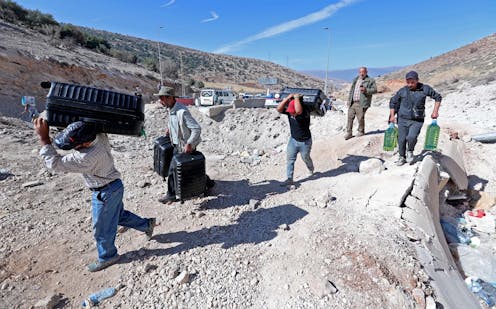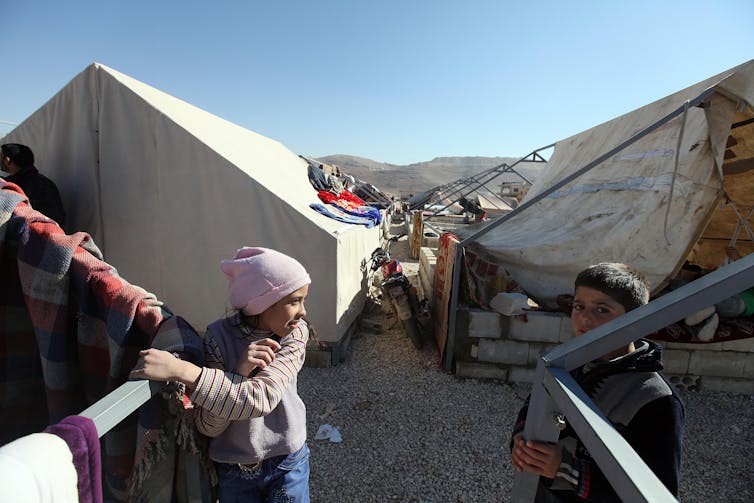
The escalation of hostilities between Israel and Hezbollah since September 2024, and Israel’s bombing of civilian areas across Lebanon, have unleashed a profound humanitarian disaster.
The mass displacement of over 1 million people, including Lebanese citizens, migrant workers and Syrian and Palestinian refugees, has created a crisis within Lebanon. Yet an equally significant phenomenon is occurring away from Lebanon’s southern border with Israel: the movement of people who have been displaced within Lebanon into Syria.
An estimated 400,000 Lebanese and Syrians have reportedly fled into Syria through overcrowded border crossings.
Not to be confused with return, this movement represents a reversal of the refugee flow that followed the descent of Syria into civil war in 2011. It is also emblematic of a broader pattern of cyclical displacement crises in the region.
The complex and intertwined histories of Lebanon and Syria – where each has at various points been a refuge for citizens of the other – challenge the simple binaries often associated with the refugee experience.
The exchange of roles between Lebanon and Syria highlights not only the fragility of regional stability but the fluidity of displacement – and the deeper implications that cross-border movement has on the sociopolitical dynamics of both countries.
A history of reciprocal refuge
The relationship between Lebanon and Syria has long been complex, oscillating between cooperation and tension. Despite Syria’s official withdrawal from Lebanon in 2005 after decades as an occupying force, the two countries remain connected due to shared borders, economic ties and security concerns. Cooperation exists in areas such as trade, but there is significant tension, especially over the presence of over 1 million Syrian refugees in Lebanon.
Yet, throughout their modern histories, one of the most enduring bonds has been the shared experiences of displacement and refuge, dating back to Lebanon’s civil war. From 1975 to 1990, thousands of Lebanese fled to Syria to escape the sectarian-driven conflict that engulfed their homeland.
The post-war period, however, was marked by a shift in the dynamics between the two countries. The 2005 withdrawal of Syrian troops from Lebanon marked a new chapter in their relations.
Tensions rose as Lebanon sought to rebuild and assert its sovereignty after nearly 30 years of Syrian occupation. Yet, the region’s tendency for upheaval soon saw the roles reversed again decades later, when an estimated 180,000 Lebanese took refuge in Syria during the 2006 July war.
With the onset of the Syrian civil war in 2011, it was Lebanon’s turn to serve as a refuge. By 2015, 1 million Syrians fleeing violence made the journey into Lebanon.
Despite being one of the 44 countries never to have signed the 1951 Refugee Convention, Lebanon is the country hosting the largest number of refugees per capita globally.
Because Lebanon didn’t sign the convention, it doesn’t formally recognize refugee status, which gives the country what it views as more control over its refugee policies. While Lebanon receives humanitarian support from the United Nations’ refugee agency, refugees remain in a precarious legal status, with limited rights.
For many Lebanese, this most recent influx of fleeing Syrian refugees has rekindled memories of their own displacement, while for others, it has fueled anti-refugee sentiments.
Bouncing between 2 war-torn countries
With the latest escalation of the Israel-Hezbollah conflict, history is again repeating itself. Lebanese citizens, primarily from Hezbollah strongholds in South Lebanon and the Beqaa Valley, are seeking refuge in Syria, a country still grappling with its own economic collapse, violence and internal strife.
While the conflict on Lebanese territory has gone on for more than a year, movements into Syria only picked up in late September 2024 as people have become more desperate to flee.
As one displaced person forced to flee from Beirut explained to me: “Syria was certainly not a ‘better’ option than Lebanon six months ago, but in the last week, since the attacks on Beirut and political assassinations, Syria is safer – despite everything it is going through. That’s how unsafe we feel in Beirut – we are bouncing between one war-torn country and another.”
Implications for refugee-host dynamics
The cyclical nature of displacement between Lebanon and Syria overturns the prevailing political narrative of host-refugee dynamics being fixed and unidirectional.
Syrian displacement to Lebanon has been portrayed by some Lebanese politicians as one-directional. This appears to be in order to frame Syrian refugees as the sole recipients of aid – as opposed to Lebanese citizens – as well as burdens on Lebanon.
When displacement occurs in both directions, however, this narrative begins to break down.
Syrian refugees who once sought safety in Lebanon now see their home country as a safer haven – albeit a fragile and temporary one. Meanwhile, Lebanese citizens face the same kinds of vulnerability and desperation that their Syrian counterparts experienced over the past decade.
Importantly, testimonies from those who are making the trip from their ‘temporary’ home in Lebanon back to Syria highlight that these movements should not be mistaken for return. Rather, they are in themselves a temporary solution.
As one Syrian who had fled his Lebanese home explained to me: “No, I am not returning. I am rather leaving one foot in Lebanon and one in Syria. Syria is in no way a safe place. As men, we are at risk of arrest and forced conscription. However, Lebanon is momentarily, at this point in history, much less safe. We do this assessment week by week. I sent my wife and my children first. I will follow.”
For their part, internally displaced Lebanese entering into Syria insist that these movements are “absolutely temporary.” One told me: “Syria is not foreign to us. It feels close and familiar. But most importantly, it feels temporary and is the right proximity to Lebanon. As soon as things calm down we will come back to our homes. Many of us have nothing to go back to, but even in this case, we will not remain in Syria.”
The strain of displacement
Both Lebanon and Syria are, in many ways, ill-equipped to handle the new wave of displacement.

By 2023, Lebanon’s economic collapse had driven 80% of its population into poverty, making it nearly impossible to absorb the additional strain of mass internal displacement.
Government paralysis, compounded by political deadlock, leaves internally displaced people with little to no state support, mostly relying on aid and community networks to survive.
Syria, though in the position of “host” in this current migratory flow, is similarly constrained. The country’s infrastructure remains devastated from more than a decade of civil war. Basic services are stretched thin, and the economy has not recovered. Humanitarian organizations coordinating the response are working amid overextended resources and dwindling support.
A region in perpetual chaos
As the armed conflict between Israel and Hezbollah escalates, the displacement crisis in Lebanon and Syria will, I fear, likely worsen.
The recent wave of Syrian refugees and Lebanese into Syria reveals the cyclical nature of refuge in the region. Ultimately, the ongoing displacement crisis in Lebanon and Syria serves as a reminder that refuge is often temporary, contingent on the shifting geopolitics of the region.
The histories of these two countries, where both have served as havens for the other’s displaced populations, underscore the complexity of displacement in the Middle East.
The fact that Lebanese citizens are now seeking shelter in Syria, a country from which over 1 million refugees fled just over a decade ago, underscores the volatility of regional displacement patterns. It also raises critical questions about the sustainability of international refugee systems that too often rely on static, one-directional models of migration and don’t account for the fluid and often reversible nature of displacement.
Jasmin Lilian Diab does not work for, consult, own shares in or receive funding from any company or organization that would benefit from this article, and has disclosed no relevant affiliations beyond their academic appointment.
This article was originally published on The Conversation. Read the original article.







